Manitou
Game preparation
With /join 2-4 players can enter the game. With /start the game begins. Alternatively, you can use the game management use.
The game
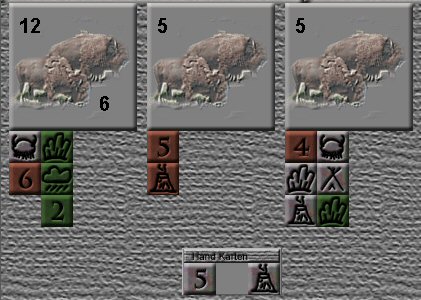
The chief assembles a hunting group from his warriors and hunters to seize buffalo and capture opponent's Indians. Those who after three hunting times (rounds) erect most buffaloes and capture most opponents win the game. But be careful - fur predators make so many strokes due to the chief.
Game sequence
Set up hunting group
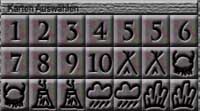
Each player has 11 hunters (numbers) and 10 warriors (figures) to choose from. Hunters come with values 1-10 each before (exception: the five is double), the warriors are double.

Heading

Medical personnel

Rain makers

Slate

Squaw

Each player selects eight cards at the beginning of each round and confirms the selection with OK. The player before the starter is allowed to select only seven cards to compensate for the advantage of being able to lay the latter. If you click, you can remove a card from the selection at any time before confirming it.

Once all players have chosen, the game begins and each player has three of his eight previously selected cards (lost by chance) on the hand. To apply, the desired card is dragged to the desired buffalo soil by drag&Drop.
Caution: Once the card has been clicked, it is automatically set to the herd on which the mouse cursor is located. Once you have clicked, you can simply drag the map (if it has not yet been released!) to the right with the table and let it go. Then the card jumps back to the hand and you can take another.
The card hand is automatically refilled to three cards.
Buffalo cards
There are three varieties of buffalo herds:
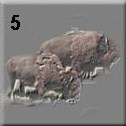
Small buffalo herds with a value of 1 to 7 (x)
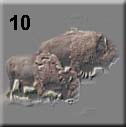
Medium buffalo soil with a value of 9 to 13 (X)
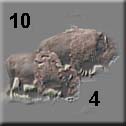
Large buffalo herds consisting of a medium and a small buffalo herd (X x)
Depending on the number of players, the buffalo cards are distributed at the three buffalo places as follows:
| Number | 1. flock | Two. flock | 3. flock |
|---|---|---|---|
| 2 | X x | x | x |
| 3 | X x | X | x |
| 4 | X x | X x | x |
Hunters
With his hunter cards you can hunt for the three buffalo herds that display different scores. For this, a hunter (number card) is placed per round to the herd that you want to hunt. The one who has the largest sum of number cards on a buffalo herd gets the points that indicate the buffalo card. With the big buffalo cards, not only the player with most score cards gets the points, but also the one who sent hunters on the second most. This then receives the smaller score. Third and fourth are empty. If only one player created hunters, he gets both scores alone. At the same time, everyone goes out empty!
Warriors
A second way to score points is to make prisoners with the warriors. As with the hunters, a warrior is placed on one of the buffalo herds.
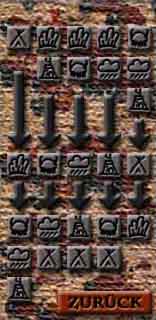
The table to the right of the field indicates which warrior is subordinate or superior.
The middle row shows the starting position: all warriors who above one another, are superior to this, all warriors below another are undermined and are beaten by the superior.
Example: In the first column, the chief is the initial position. Above it is the squaw that can beat the chief. Below the chief is the medical man, the rainmaker and the scout. These three are beaten by the chief.
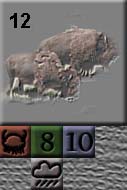
It can only be the warrior of a player at a herd of the winners. This is displayed in the player's color, as in this example the medical man (red helmet).
If another player puts his warrior who is above the already lying in the table, the color of the subordinate changes to gray and the superior is active (color). In this example, the cloud (rainmaker of green) was first played and then defeated by laying the red medical man.
If a player sets the same warrior as the currently active warrior, both are neutralized and discolor gray. None of them are now active and you can now lay any warrior who is considered active.
Anyone who has placed the last active (colored) hero on a herd at the end of the round will receive all opposing hunters and beaten warriors who are on this herd as prisoners. Every prisoner counts a point. You get your own hunters and beaten warriors back and can send them back to the hunt in the next round. The prisoners are lost for the fellow players for the rest of the game.
The medical man in this example would take 3 prisoners (green 8, green rain makers, blue 10), thus would be 3 points for red. These bonus points are shown small at the end of the round at the lower end of the respective herd.
Protect warriors
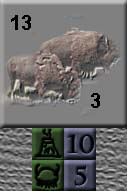
To protect his own active warriors, you can add a second warrior. However, more than two active warriors of a player must not be placed on a flock. The first active warrior is now protected by the second active warrior. The co-players must first turn off the last-placed warrior by a "victim" before they can attack the first-placed warrior. Victims means that the attacking warrior also "kills". Both, the attacker and the protective warrior, are therefore inactive and colour grey. Only the next attacker can now defeat the upper active warrior.
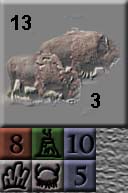
In this example, the green scout is first protected by the green medical man. Red now sacrifices his chief: the red chief defeats the green medical man, but his life turns out to be grey. Now red or blue can try to defeat the scout.
Round settlement
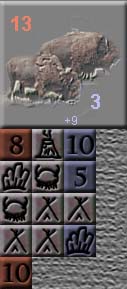
One round ends when each player has placed seven of his eight cards. A card thus always remains on the hand and is not played out. It is available for selection in the next round.
Now all three buffalo herds are counted:
- the player with most hunters (sum of number cards) gets the highest score of the herd (here 13 points for red). If it is a large herd (with two numbers), the one with the second most hunters gets the smaller number (here three points for blue).
- the player who finally has the last active warrior on the flock gets all opposing cards as prisoners: one point per prisoner (nine points for blue).
These points are displayed in the corresponding player color on the buffalo card.
After billing, each player must click on the field to confirm the next hunting season.
The fur predator
The Indian tribe, taken together in a round at all herds, has used most hunters (sums of numbers, not the number of hunters), naturally attracts the fur predators by its prey. These give him ten buffalo bands, which gives him -10 points.
Playing
The game ends after three hunting times (rounds). The player with the highest score wins.

